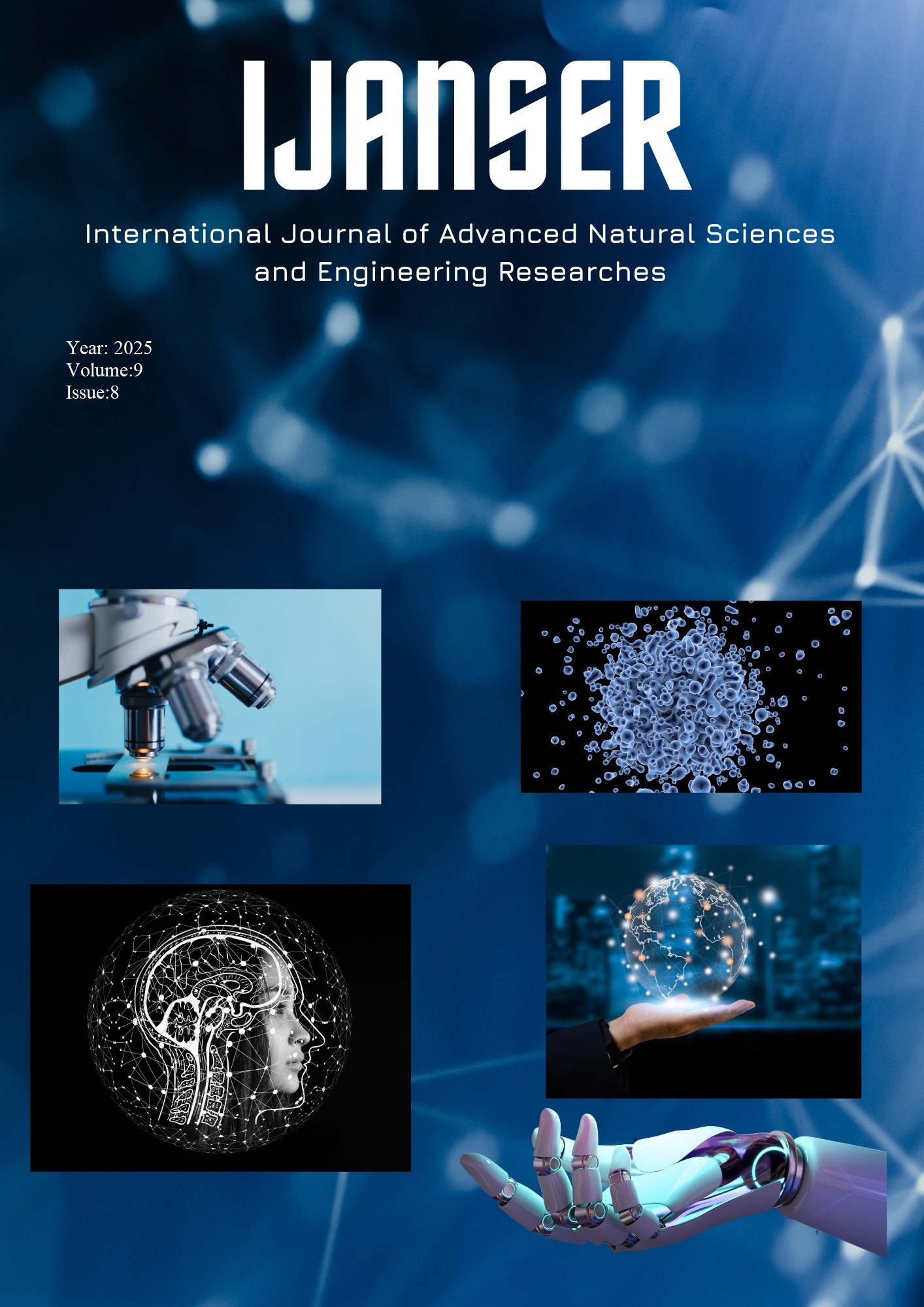A Graph-Driven Machine Learning Framework for Biomedical Prediction and Spectral Network Modeling
Keywords:
Machine Learning, Cardiovascular Risk, Decision Tree, Graph-Based Modelling, Microbiome Networks, Spectral Analysis, Health InformaticsAbstract
The increasing intricacy of biomedical systems has necessitated the development of integrated
computational models that merge predictive precision with structural clarity. This article outlines the
creation and validation of a machine learning-based clinical decision support system for the early
evaluation of heart attack risk, enhanced by a conceptual network architecture relevant to broader
biological contexts, including microbiomes. A clinical dataset comprising nine cardiovascular markers
was used to assess three supervised algorithms: K-Nearest Neighbors, Naive Bayes, and Decision Tree.
The decision tree achieved an accuracy of 98%, validating its efficacy for structured health data. A
Python-based interface was developed, facilitating both manual and PDF data input for real-time clinical
use.
In addition to categorisation, each patient was represented as a node in a similarity network, facilitating
the conversion of flat data into a topological structure. The outputs of machine learning were interpreted
as node labels, serving as the foundation for subsequent applications in microbiome-host interaction
networks and gene co-expression research. This method facilitates the application of spectral graph
techniques, including Laplacian eigenvalue analysis and matrix functionals (e.g., exp(A), cosh(A)), to
investigate structural disturbances in biological systems.
This twin contribution—an accurate clinical prediction tool and a transferable graph-based modelling
framework—facilitates transdisciplinary applications in systems biology and computational
epidemiology. This study advances digital health initiatives by integrating machine learning with
topological reasoning, providing a reproducible basis for predictive modelling in biologically intricate,
network-structured fields.
Downloads
References
Alshraideh, M., Alshraideh, N., Alshraideh, A., Alkayed, Y., Trabsheh, Y. A., & Alshraideh, B. (2024). Enhancing heart attack prediction with machine learning: A study at Jordan University Hospital. Applied Computational Intelligence and Soft Computing, 2024, Article ID 5080332. https://doi.org/10.1155/2024/5080332
Barabási, A.-L., & Albert, R. (1999). Emergence of scaling in random networks. Science, 286(5439), 509–512. https://doi.org/10.1126/science.286.5439.509
Barabási, A.-L., Gulbahce, N., & Loscalzo, J. (2011). Network medicine: A network-based approach to human disease. Nature Reviews Genetics, 12(1), 56–68. https://doi.org/10.1038/nrg2918
Estrada E., The structure of complex networks, Theory and Application, Oxford University Press, 2011 ISBN 978-0-19-959175-6.
Gao, J., Lin, Y., & Wang, J. (2019). Spectral characterization of microbiota in health and disease. PLoS Computational Biology, 15(7), e1007146. https://doi.org/10.1371/journal.pcbi.1007146
Kalluçi, E., Preni, B., X. Dhamo, Noka, E., Bardhi, S., Bani, K., Macchia, A., Bonetti, G., Dhuli, K., Donato, K., Bertelli, M., Zambrano, L. J. M., Janaqi, S., “A comparative study of supervised and unsupervised machine learning algorithms applied to human microbiome”, Clin Ter 2024; 175 (3):98-116, https://doi.org/10.7417/ct.2024.5051, https://clinicaterapeutica.it/ojs/index.php/1/article/view/882/636
Kapçiu, R., Preni, B., & Kalluçi, E. (2024a). IT-Enabled WGCNA for Critical Gene Module Mapping and Therapy Optimization: Advancing Leukemia Care. Transdisciplinary Journal of Engineering & Science, 15. https://doi.org/10.22545/2024/00252
Kapçiu, R., Preni, B., Kalluçi, E., & Kosova, R. (2024b). MODELING INFLATION DYNAMICS USING THE LOGISTIC MODEL: INSIGHTS AND FINDINGS. Jurnal Ilmiah Ilmu Terapan Universitas Jambi|JIITUJ|, 8(1), 364–378. https://doi.org/10.22437/jiituj.v8i1.32605
Kapil, A. R. (2022). Decision tree algorithm in machine learning: Advantages, disadvantages, and limitations. AnalytixLabs. https://www.analytixlabs.co.in/blog/decision-tree-algorithm
Liu, Y. Y., Slotine, J. J., & Barabási, A. L. (2020). Controllability of complex networks. Nature, 473(7346), 167–173. https://doi.org/10.1038/nature10011
Marcos-Zambrano, L. J., López-Molina, V. M., Bakir-Gungor, B., Frohme, M., Karaduzovic-Hadziabdic, K., Klammsteiner, T., Ibrahimi, E., Lahti, L., Loncar-Turukalo, T., Dhamo, X., Simeon, A., Nechyporenko, A., Pio, G., Przymus, P., Sampri, A., Trajkovik, V., Lacruz-Pleguezuelos, B., Aasmets, O., Araujo, R., . . . De Santa Pau, E. C. (2023). A toolbox of machine learning software to support microbiome analysis. Frontiers in Microbiology, 14. https://doi.org/10.3389/fmicb.2023.1250806
Pedregosa, F., Varoquaux, G., Gramfort, A., Michel, V., Thirion, B., Grisel, O., ... & Duchesnay, É. (2011). Scikit-learn: Machine learning in Python. Journal of Machine Learning Research, 12, 2825–2830. https://www.jmlr.org/papers/volume12/pedregosa11a/pedregosa11a.pdf
Rashid, T. A., & Hassan, B. (2022). Heart attack dataset. Mendeley Data, V1. https://doi.org/10.17632/wmhctcrt5v.1
Saravanan, T., Raghavaraju, D., Bhaskar, M. V., & Vasundra, S. (2023). Prediction of heart disease using machine learning and hybrid methods. In Proceedings of the 2023 1st International Conference on Optimization Techniques for Learning. https://doi.org/10.1109/ICOTL59758.2023.10435033
Sherrell, Z. (2021, October 22). What to know about blood tests to diagnose a heart attack. Medical News Today. https://www.medicalnewstoday.com/articles/blood-tests-for-heart-attack
Tabaku, E., Vyshka, E., Kapçiu, R., Shehi, A., & Smajli, E. (2025). UTILIZING ARTIFICIAL INTELLIGENCE IN ENERGY MANAGEMENT SYSTEMS TO IMPROVE CARBON EMISSION REDUCTION AND SUSTAINABILITY. Jurnal Ilmiah Ilmu Terapan Universitas Jambi|JIITUJ|, 9(1), 393–405. https://doi.org/10.22437/jiituj.v9i1.38665
Venkatesh, D., Saravanan, T., Raghavaraju, D., Bhaskar, M. V., & Vasundra, S. (2023). Prediction of heart disease using machine learning and hybrid methods. 2023 1st International Conference on Optimization Techniques for Learning. https://doi.org/10.1109/ICOTL59758.2023.10435033
Watts, D. J., & Strogatz, S. H. (1998). Collective dynamics of ‘small-world’ networks. Nature, 393(6684), 440–442. https://doi.org/10.1038/30918
World Health Organization. (2023). Cardiovascular diseases (CVDs). https://www.who.int/news-room/fact-sheets/detail/cardiovascular-diseases-(cvds)





